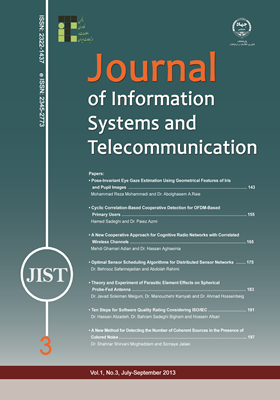Pose-Invariant Eye Gaze Estimation Using Geometrical Features of Iris and Pupil Images
محورهای موضوعی : Image ProcessingMohammad Reza Mohammadi 1 , Abolghasem Asadollah Raie 2
1 - Amirkabir
2 - Amirkabir
کلید واژه: Gaze Estimation, Projective Geometry, Video-Based Human–Computer Interface, Pupil Center Localization, Iris Ellipse Fitting,
چکیده مقاله :
In the cases of severe paralysis in which the ability to control the body movements of a person is limited to the muscles around the eyes, eye movements or blinks are the only way for the person to communicate. Interfaces that assist in such communications often require special hardware or reliance on active infrared illumination. In this paper, we propose a non-intrusive algorithm for eye gaze estimation that works with video input from an inexpensive camera and without special lighting. The main contribution of this paper is proposing a new geometrical model for eye region that only requires the image of one iris for gaze estimation. Essential parameters for this system are the best fitted ellipse of the iris and the pupil center. The algorithms used for both iris ellipse fitting and pupil center localization pose no pre-assumptions on the head pose. All in all, the achievement of this paper is the robustness of the proposed system to the head pose variations. The performance of the method has been evaluated on both synthetic and real images leading to errors of 2.12 and 3.48 degrees, respectively.
In the cases of severe paralysis in which the ability to control the body movements of a person is limited to the muscles around the eyes, eye movements or blinks are the only way for the person to communicate. Interfaces that assist in such communications often require special hardware or reliance on active infrared illumination. In this paper, we propose a non-intrusive algorithm for eye gaze estimation that works with video input from an inexpensive camera and without special lighting. The main contribution of this paper is proposing a new geometrical model for eye region that only requires the image of one iris for gaze estimation. Essential parameters for this system are the best fitted ellipse of the iris and the pupil center. The algorithms used for both iris ellipse fitting and pupil center localization pose no pre-assumptions on the head pose. All in all, the achievement of this paper is the robustness of the proposed system to the head pose variations. The performance of the method has been evaluated on both synthetic and real images leading to errors of 2.12 and 3.48 degrees, respectively.


